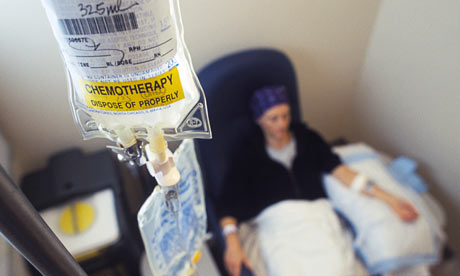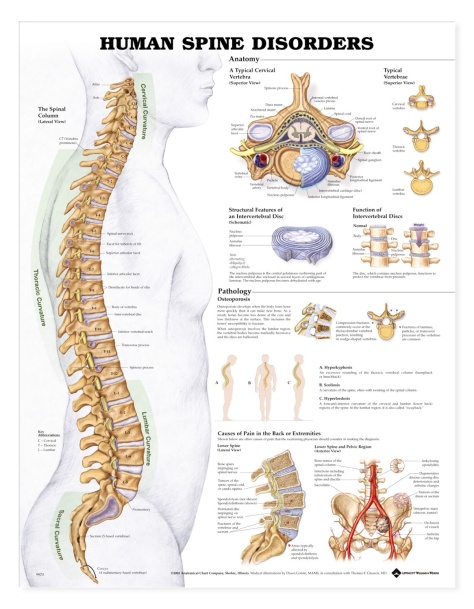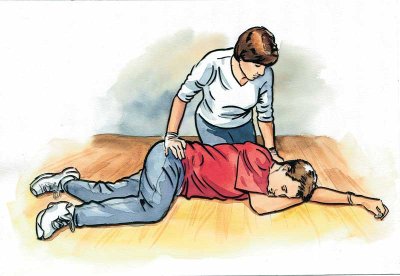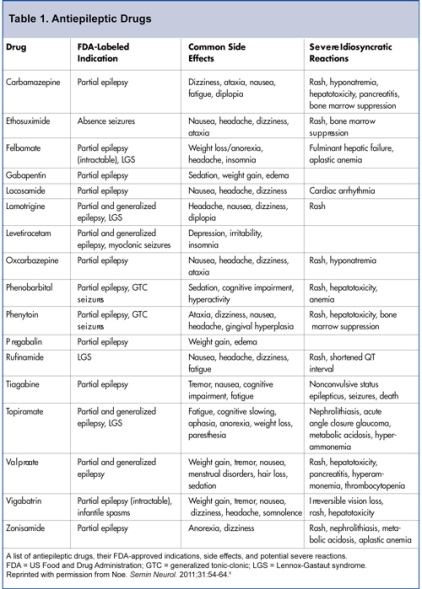 Do you wonder if you have arthritis? Do you have pain, stiffness, fatigue? What can you do to determine whether it is arthritis or structural stress and pain and are there things you can do to treat it naturally? Find out more in this informative article. Continue reading
Do you wonder if you have arthritis? Do you have pain, stiffness, fatigue? What can you do to determine whether it is arthritis or structural stress and pain and are there things you can do to treat it naturally? Find out more in this informative article. Continue reading
Tag Archives: Yoga
30 Tips for Reducing Stress Naturally
 Are you feeling worried or stressed? Wondering how to avoid family conflicts? Feeling hopeless about managing your finances? Feeling overwhelmed, tired or fatigued? Looking for a way out? It’s the time of year when most of us are experiencing heightened feelings of anxiety and worry. Here are 30 safe and quick tips that have shown to be effective in reducing stress and anxiety any time of the year. Continue reading
Are you feeling worried or stressed? Wondering how to avoid family conflicts? Feeling hopeless about managing your finances? Feeling overwhelmed, tired or fatigued? Looking for a way out? It’s the time of year when most of us are experiencing heightened feelings of anxiety and worry. Here are 30 safe and quick tips that have shown to be effective in reducing stress and anxiety any time of the year. Continue reading
What is Generalized Anxiety Disorder? – Causes, Symptoms, Treatment
 Generalized Anxiety Disorder
Generalized Anxiety Disorder
People with Generalized Anxiety Disorder or GAD experience an excessive amount of worry about everyday subjects such as work, family, friends, and health. The National Center for Complementary and Alternative Medicine (NCCAM) (2013) states that “Anxiety disorders affects about 40 million Americans age 18 years and older (about 18 percent) in a given year”. The feeling of anxiety is persistent and lasts for more than 6 months.
People with GAD tend to exaggerate the feeling of uneasiness and tension when there is no reason to worry. The disorder may keep people from doing things they enjoy because they are fearful of the consequences.
The disorder can develop at any age of a person’s lifetime whether it is during childhood or adulthood. The symptoms of the disorder can mimic other mood disorders such as obsessive compulsive disorder. Generalized Anxiety Disorder can be a life-long condition. Women are twice more likely to be diagnosed with the illness than men (Anxiety and Depression Association of America, 2014).
 Causes of GAD
Causes of GAD
The cause(s) of Generalized Anxiety Disorder are unknown. There is evidence that the condition may be inherited however the findings are inconclusive. Environmental factors may play a role in the progression of the illness. Living in a stressful household or working in an uneasy workplace may exacerbate GAD (National Institute of Mental Health [NIMH], 2014).
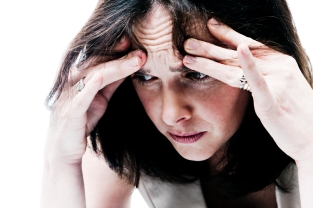 Symptoms of GAD
Symptoms of GAD
The National Institute of Mental Health (2014) states that the physical symptoms of anxiety are “fatigue, headaches, muscle tension, muscle aches, difficulty swallowing, trembling, twitching, irritability, sweating, nausea, lightheadedness, having to go to the bathroom frequently, feeling out of breath, and hot flashes.” Mayo Clinic (2014) provides a list of the general symptoms people may exhibit from the condition. The symptoms include, but are not limited to the following:
- Persistent worrying or obsession about small or large concerns that’s out of proportion to the impact of the event
- Inability to set aside or let go of a worry
- Inability to relax, restlessness, and feeling keyed up or on edge
- Difficulty concentrating, or feeling that your mind “goes blank”
- Worrying about excessively worrying
- Distress about making decisions for fear of making the wrong decision
- Carrying every option in a situation all the way out to its possible negative conclusion
- Difficulty handling uncertainty or indecisiveness
“People with GAD can’t seem to get rid of their concerns, even though they usually realize that their anxiety is more intense than the situation warrants. They can’t relax, startle easily, and have difficulty concentrating. Often they have trouble falling asleep or staying asleep.” -National Institute of Mental Health (2014)
 Diagnosis of GAD
Diagnosis of GAD
When a person has persistent and excessive feelings of uneasiness, anxiety and worry for longer than 6 months, it is recommended to seek a medical professional to receive a diagnosis. Since the cause(s) of Generalized Anxiety Disorder are unknown, it can be difficult to properly diagnose the disorder without ruling out other illnesses that manifest similar symptoms. The doctor will perform a thorough mental health examination. If Generalized Anxiety Disorder is diagnosed, the doctor will discuss proper forms of treatment.
Treatments for GAD
Generalized Anxiety Disorder is commonly treated with three types of treatments: psychotherapy, medication, or lifestyle changes. In psychotherapy, cognitive behavior therapy is beneficial for people suffering from GAD.
 The National Alliance on Mental Illness (2012) states that “Cognitive behavior therapy is a form of treatment that focuses on examining the relationships between thoughts, feelings and behaviors”. People learn to think and react differently to certain stressful situations to prevent self-destructive behaviors and negative thoughts that could cause anxiety. Anti-anxiety medications such as benzodiazepines are used to treat GAD.
The National Alliance on Mental Illness (2012) states that “Cognitive behavior therapy is a form of treatment that focuses on examining the relationships between thoughts, feelings and behaviors”. People learn to think and react differently to certain stressful situations to prevent self-destructive behaviors and negative thoughts that could cause anxiety. Anti-anxiety medications such as benzodiazepines are used to treat GAD.
Antidepressant medications such as Prozac are also helpful in treating mood disorders; however people can have suicidal thoughts while on antidepressants.
Natural Holistic Lifestyle Changes
Mayo Clinic lists the following natural lifestyle changes that are helpful in preventing and treating GAD:
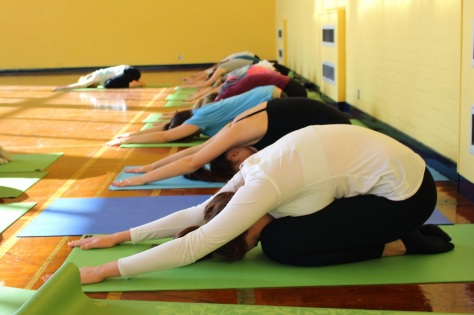
- Keep physically active. Develop a routine so that you’re physically active most days of the week. Exercise is a powerful stress reducer. It may improve your mood and help you stay healthy. Start out slowly and gradually increase the amount and intensity of your activities.
- Avoid alcohol and other sedatives. These substances can worsen anxiety.
- Quit smoking and cut back or quit drinking coffee. Both nicotine and caffeine can worsen anxiety.
- Make sleep a priority. Do what you can to make sure you’re getting enough sleep to feel rested. If you aren’t sleeping well, see your doctor.

- Eat healthy. Healthy eating-such as focusing on vegetables, fruits, whole grains and fish- may be linked to reduced anxiety, but more research is needed.
Alternative Treatments for Generalized Anxiety Disorder
In addition to the natural holistic lifestyle changes listed above, there are other effective natural and alternative methods for treating Generalized Anxiety Disorder. Some of the most popular methods are: acupuncture,yoga, and meditation.
Acupuncture is a form of Chinese medicine that focuses on the human body’s flow of energy. With acupuncture, needles are inserted into certain areas of the body. Acupuncture is becoming more widely used as a treatment for a wide variety of mood disorders.
Yoga is a Hindu philosophy.  The goal of practicing yoga is to gain control over the mind and body through physical postures and breathing exercises. Research studies show that yoga can significantly reduce symptoms of stress and anxiety.
The goal of practicing yoga is to gain control over the mind and body through physical postures and breathing exercises. Research studies show that yoga can significantly reduce symptoms of stress and anxiety.
Meditation is a type of relaxation technique  people use to calm the mind and to eliminate negative thoughts (National Center for Complementary and Alternative Medicine, 2013). Many research studies have been conducted on the effects of meditation in reducing anxiety and stress. Recently the United States government has been conducting research using meditation with men and women in the military. See our article, “Marines are Meditating! Mindfulness- Based Fitness.”
people use to calm the mind and to eliminate negative thoughts (National Center for Complementary and Alternative Medicine, 2013). Many research studies have been conducted on the effects of meditation in reducing anxiety and stress. Recently the United States government has been conducting research using meditation with men and women in the military. See our article, “Marines are Meditating! Mindfulness- Based Fitness.”
Generalized Anxiety Disorder (GAD) is a serious condition which can begin at any age in a person’s lifetime. If you believe you have GAD and your symptoms have lasted for more than six months, consult with your trusted family physician or health practitioner. There are many treatment options available to help you.
References
Anxiety and Depression Association of America. (2014). Treating Anxiety Disorders. Complementary & Alternative Treatment. Retrieved November 18, 2014, from http://www.adaa.org/understanding-anxiety/generalized-anxiety-disorder-gad
Duckworth, K., & Freedman, J. (2012, July). Treatment and Services. Retrieved November 19, 2014, from http://www.nami.org/Content/NavigationMenu/Inform_Yourself/
About_Mental_Illness/About_Treatments_and_Supports/Cognitive
_Behavioral_Therapy1.htm
Mayo Clinic. (2014). Definition. Generalized Anxiety Disorder. Retrieved November 21, 2014 from, http://www.mayoclinic.org/diseases-conditions/generalized-anxiety-disorder/basics/definition/con-20024562
National Center for Complementary and Alternative Medicine. (2013). Anxiety. Retrieved November 21, 2014 from, http://nccam.nih.gov/health/anxiety
National Institute of Mental Health. (2014). What is Generalized Anxiety Disorder?. Generalized Anxiety Disorder (GAD). Retrieved November 21, 2014 from, http://www.nimh.nih.gov/health/topics/generalized-anxiety-disorder-gad/index.shtml
__________________________________________________
This article is written by Hang Pham. Hang Pham is a Monterey Bay Holistic Alliance Health and Wellness Educator. Hang Pham was born in Hoc Mon, Vietnam. She came to America in 1994, becoming a U.S. citizen in 2011. Hang graduated from Seaside High School with diploma and received her AA in General Studies from Monterey Peninsula College in 2011. She received her BA in Collaborative Health and Human Services from California State University Monterey Bay (CSUMB) in 2012. In addition to working as a volunteer staff with the Monterey Bay Holistic Alliance, she currently works as a Clerical Aid in the Human Resources Department of Salinas City Hall. The Monterey Bay Holistic Alliance is a registered 501 (c) 3 nonprofit health and wellness education organization. For more information about the Monterey Bay Holistic Alliance contact us or visit our website at www.montereybayholistic.com.
is written by Hang Pham. Hang Pham is a Monterey Bay Holistic Alliance Health and Wellness Educator. Hang Pham was born in Hoc Mon, Vietnam. She came to America in 1994, becoming a U.S. citizen in 2011. Hang graduated from Seaside High School with diploma and received her AA in General Studies from Monterey Peninsula College in 2011. She received her BA in Collaborative Health and Human Services from California State University Monterey Bay (CSUMB) in 2012. In addition to working as a volunteer staff with the Monterey Bay Holistic Alliance, she currently works as a Clerical Aid in the Human Resources Department of Salinas City Hall. The Monterey Bay Holistic Alliance is a registered 501 (c) 3 nonprofit health and wellness education organization. For more information about the Monterey Bay Holistic Alliance contact us or visit our website at www.montereybayholistic.com.
Disclaimer: The Monterey Bay Holistic Alliance is a charitable, independent registered nonprofit 501(c)3 organization and does not endorse any particular products or practices. We exist as an educational organization dedicated to providing free access to health education resources, products and services. Claims and statements herein are for informational purposes only and have not been evaluated by the Food and Drug Administration. The statements about organizations, practitioners, methods of treatment, and products listed on this website are not meant to diagnose, treat, cure, or prevent any disease. This information is intended for educational purposes only. The MBHA strongly recommends that you seek out your trusted medical doctor or practitioner for diagnosis and treatment of any existing health condition.
Cancer: An Overview of the Diseases – Causes, Symptoms and Treatment
What is Cancer?
Cancer is a word used for more than 100 diseases. The subject of cancer is extremely vast. Each type of cancer is different and varies greatly to each other. This article will focus on cancer in general, and will not describe one kind of cancer in much detail. To fully comprehend the word, there needs to be some dissection of the human cell. Each cell contains deoxyribonucleic acid (DNA) which is genetic material that makes up all humans.
Normal cells divide to create new cells and eventually die when they are not needed anymore. Cancer cells do not die; they continue to grow, and form abnormal cells that invade other tissues in the body. The body doesn’t need these cancer cells. The DNA in these cancer cells are damaged due to an injury or the environment, thus any cells created onward from these cells will be flawed as well. A mass is formed from the cancer cells called a tumor.

Cancer cells can spread to other parts of the body through the blood stream. More tumors can grow as a result of this migration. Tumors can crowd normal tissues in the body. Tumors are not cancerous by definition. Some tumors are benign and some are malignant. Benign tumors can grow and cause minor health issues; however they can’t invade other tissues. Malignant tumors are cancerous and invade other tissues. Doctors who specialize in cancer diagnosis and treatment are called oncologists. These physicians work with their patients on a one-on-one basis to create an appropriate plan for treatment (National Cancer Institute, 2014).
Categories of Cancer
The National Cancer Institute (2014) provides a description of the main categories of cancer in the following:
- Carcinoma- cancer that begins in the skin or in tissues that line or cover internal organs. There are a number of subtypes of carcinoma, including adenocarcinoma, basil cell carcinoma, squamous cell carcinoma, and transitional cell carcinoma.
- Sarcoma- cancer that begins in bone, cartilage, fat, muscle, blood vessel, or other connective or supportive tissue.
- Leukemia- cancer that starts in blood-forming tissue such as the bone marrow and causes large numbers of abnormal blood cells to be produced and enter the blood.
- Lymphoma and myeloma- cancers that begin in the cells of the immune system.
- Central nervous system cancers- cancers that begin in the tissues of the brain and spinal cord.
Statistics on Cancer
The American Cancer Society estimates that in 2014, the United States will have over a million new cases of cancer and over five hundred thousand deaths. Millions of people survive cancer each year. The number of survivors of cancer has been steadily increasing every year.
Over 13 million people in the United States have been diagnosed with cancer, and lung cancer has been reported with the highest percentage of deaths among both men and women. There are many different types of cancer. The risk of developing cancer increases with age. Some cancers are more prevalent among certain populations, and some are exclusive to one gender such is the case with Prostate Cancer and men.

Breast Cancer afflicts more than 2 million women in the United States. If Breast Cancer is caught in the early stages, the chances for survival are over 95%. Cancer as a diagnosis doesn’t necessarily mean the person will die from the disease. Millions of people survive from cancer each year (American Cancer Society, 2014).
Causes of Cancer
Cancer can be caused by one or more factors. The American Cancer Society states that the causes of cancer are connected with genetics, tobacco, diet, physical activity, sun exposure, radiation exposure and other carcinogens.
 Some cancers are hereditary due to an abnormal gene mutation being passed down from parent to child. Up to one-tenth of all cancers are inherited. Smoking cigarettes/cigars are very dangerous and can be detrimental to a person’s health. Smoking cigarettes has been proven to cause different types of cancer such as lung, oral, and esophageal cancer.
Some cancers are hereditary due to an abnormal gene mutation being passed down from parent to child. Up to one-tenth of all cancers are inherited. Smoking cigarettes/cigars are very dangerous and can be detrimental to a person’s health. Smoking cigarettes has been proven to cause different types of cancer such as lung, oral, and esophageal cancer.

There is a link between diet and physical activity and cancer. Poor diet and lack of regular physical activity increases the chances of developing the disease. Research studies show that aerobic exercise and weight training boosts the immune system in cancer survivors and lowers the risk of cancer.
Over 33% of deaths from cancer are related to poor diet (American Cancer Society, 2014). Diets high in trans fats can increase the risk of cancer. See our article “What is Good Fat?” and “20 Cancer-Fighting Foods.” Recent studies have shown that increasing acidity and lowering cancer cell pH (increasing acidity) is effective against cancer cell mitosis in the laboratory studies.
Extensive lifetime exposure to UV rays in sunlight can lead to Skin Cancers such as basil cell and melanoma cell cancers. Radiation exposure agents include x-rays and gamma rays. The Radiation Emergency Assistance Center/Training Site (2014) describes the characteristics of x-rays and gammas rays as “electromagnetic radiation like visible light, radio waves, and ultraviolet light”. High and frequent exposure to these agents causes cancer. People who work in nuclear power plants have a greater risk of developing cancer cells than those working in regular office buildings. Small amounts of these agents can be found in medical imaging tests and other sources. Carcinogens or environmental factors leading to cancer provided by the American Cancer Society include:
- Lifestyle factors (nutrition, tobacco use, physical activity, etc.)
- Naturally occurring exposures (ultraviolet light, radon gas, infectious agents, etc.)
- Medical treatments (chemotherapy, radiation, immune system-suppressing drugs, etc.)
- Workplace exposures
- Household exposures
- Pollution
Symptoms of Cancer
The symptoms of cancer depend on the type of cancer you may have. Mayo Clinic (2014) provides a list of the general symptoms people may exhibit from the diseases.
 The symptoms include, but are not limited to the following:
The symptoms include, but are not limited to the following:
- Fatigue
- Lump or area of thickening that can be felt under the skin
- Weight changes, including unintended loss or gain
- Skin changes, such as yellowing, darkening or redness of the skin, sores that won’t heal, or changes to existing moles
- Changes to bowel or bladder habits
- Persistent cough
- Difficulty swallowing
- Hoarseness
- Persistent indigestion or discomfort after eating
- Persistent, unexplained muscle or joint pain
- Persistent, unexplained fevers or night sweats
Diagnosis of Cancer
Physical self-examinations are important preventative measures to diagnosing cancer. If you display one or more of the symptoms expressed in the previous passage, it’s recommended to seek out a physician for a professional opinion. The physician will perform a physical examination of the area in question and take a complete medical history.

A biopsy is usually performed by taking a sample of the lump and examining the cells under a microscope. The American Cancer Society (2014) states that other tests that may be performed include: “x-rays, computed tomography (CT), magnetic resonance imaging (MRI), ultrasound, and fiber-optic endoscopy examinations”. If the tests come back positive for cancer cells, more tests need to be performed to determine exactly what kind of cancer is present and in what stage the cancer is in which is process called staging. The National Cancer Institute has created a chart to show how oncologists categories the stage of their patient’s cancer. The Cancer Staging Chart is provided below.
Stage |
Definition |
| Stage 0 | Carcinoma in situ (abnormal cells are present only in the layer of cells in which they developed) |
| Stage I, Stage II, and Stage III | Higher numbers indicate more extensive disease: Larger tumor size and/or spread of the cancer beyond the organ in which it first developed to nearby lymph nodes and/or tissues or organs adjacent to the location of the primary tumor |
| Stage IV | The cancer has spread to distant tissues or organs |
Chart A: Cancer Staging Chart
Treatment of Cancer
Cancer can be treated in many different ways. The traditional methods to treating cancer are surgery, chemotherapy, and radiation therapy. New treatments are targeted therapy, immunotherapy, hyperthermia, stem cell transplant, photodynamic therapy, and laser in cancer treatment. Surgery is most often used to get rid of cancer growing inside the body.
Chemotherapy is the use of certain Food and Drug Administration Approved or FDA drugs and medicines to combat the cancer. With radiation therapy, a high-energy beam targeted at the site of the cancer is used. In some cases, a combination of these treatments has been proven to be very effective in getting rid of cancer cells (National Cancer Institute, 2014).
Complementary/Alternative Treatments of Cancer
Complementary/Alternative treatments have not been proven to cure cancer; however they play an active role in reliving the side-effects of cancer treatments. People who are diagnosed with cancer sometimes choose other methods for a variety of reasons.
 The National Cancer Institute (2014) describes some of these reasons below:
The National Cancer Institute (2014) describes some of these reasons below:
- They would like to relieve the side effects of mainstream cancer treatment without having to take more medicine.
- They are seeking a less unpleasant treatment approach that might have fewer side effects.
- They want to take an active role in improving their own health and wellness.
- They prefer alternative theories of health and disease, as well as alternative treatments.
In addition to making changes in nutrition, diet and physical exercise, other types of complementary/alternative treatments can help in relieving the side-effects of cancer treatments and in lowering the risk of cancer. The complementary/alternative treatments are specific to the side-effects that manifest.
The Mayo Clinic (2014) provides a chart to show the most appropriate treatment to try for each side-effect from traditional cancer treatments.
If you’re experiencing |
Then consider trying |
| Anxiety | Hypnosis, massage, meditation, relaxation techniques |
| Fatigue | Exercise, massage, relaxation techniquesn, yoga |
| Nausea and vomiting | Acupuncture, aromatherapy,hypnosis, music therapy |
| Pain | Acupuncture, aromatherapy,hypnosis, biofeedback, massage music therapy |
| Sleep problems | Exercise relaxation techniquesn, yoga |
| Stress | Aromatherapy, hypnosis, massage, meditation,exercise, tai chi, yoga |
Chart B: Alternative Treatment Chart
References
American Cancer Society. (2014). Understanding Cancer. Cancer Basics. Retrieved October 16, 2014, from http://www.cancer.org/cancer/cancerbasics/index
Guidance for Radiation Accident Management. (2014). Characteristics of Gamma Radiation and X-Rays. Basics of Radiation. Retrieved October 17, 2014, from https://orise.orau.gov/reacts/guide/gamma.htm
Mayo Clinic. (2014). Definition. Cancer. Retrieved October 18, 2014, from http://www.mayoclinic.org/diseases-conditions/cancer/basics/definition/con-20032378
National Cancer Institute. (2014). Defining Cancer. What is Cancer?. Retrieved October 18, 2014, from http://www.cancer.gov/cancertopics/cancerlibrary/what-is-cancer
__________________________________________________
This article is written by Hang Pham. Hang Pham is a Monterey Bay Holistic Alliance Health and Wellness Educator. Hang Pham was born in Hoc Mon, Vietnam. She came to America in 1994, becoming a U.S. citizen in 2011. Hang graduated from Seaside High School with diploma and received her AA in General Studies from Monterey Peninsula College in 2011. She received her BA in Collaborative Health and Human Services from California State University Monterey Bay (CSUMB) in 2012. In addition to working as a volunteer staff with the Monterey Bay Holistic Alliance, she currently works as a Clerical Aid in the Human Resources Department of Salinas City Hall. The Monterey Bay Holistic Alliance is a registered 501 (c) 3 nonprofit health and wellness education organization. For more information about the Monterey Bay Holistic Alliance contact us or visit our website at www.montereybayholistic.com.
is written by Hang Pham. Hang Pham is a Monterey Bay Holistic Alliance Health and Wellness Educator. Hang Pham was born in Hoc Mon, Vietnam. She came to America in 1994, becoming a U.S. citizen in 2011. Hang graduated from Seaside High School with diploma and received her AA in General Studies from Monterey Peninsula College in 2011. She received her BA in Collaborative Health and Human Services from California State University Monterey Bay (CSUMB) in 2012. In addition to working as a volunteer staff with the Monterey Bay Holistic Alliance, she currently works as a Clerical Aid in the Human Resources Department of Salinas City Hall. The Monterey Bay Holistic Alliance is a registered 501 (c) 3 nonprofit health and wellness education organization. For more information about the Monterey Bay Holistic Alliance contact us or visit our website at www.montereybayholistic.com.
Disclaimer: The Monterey Bay Holistic Alliance is a charitable, independent registered nonprofit 501(c)3 organization and does not endorse any particular products or practices. We exist as an educational organization dedicated to providing free access to health education resources, products and services. Claims and statements herein are for informational purposes only and have not been evaluated by the Food and Drug Administration. The statements about organizations, practitioners, methods of treatment, and products listed on this website are not meant to diagnose, treat, cure, or prevent any disease. This information is intended for educational purposes only. The MBHA strongly recommends that you seek out your trusted medical doctor or practitioner for diagnosis and treatment of any existing health condition.
Back Pain: Causes and Alternative and Natural Treatments
What Is the Anatomy of the Human Back?
The human back is made up of bones, muscles, tendons and ligaments. These parts make up the spinal column. The spinal column consists of 30 bones called the vertebrae. The spinal column helps hold up the upper part of the body. The back is an integral part of the human body (National Institute of Arthritis and Musculoskeletal and Skin Diseases [NIAMS], 2013.
Why Do We Experience Back Pain?
 Back pain can affect people of all ages and ethnicities. Back pain can be acute or chronic. Acute back pain usually lasts a couple of days and is generally treated by orthodox practitioners by Ibuprophen or other over-the-counter pain medications or prescription drugs. However, people can becoming addicted to pain medications especially with chronic pain. Chronic back pain normally occurs for more than three months. Older people are more susceptible to back pain because as they age, their bone strength decreases and muscles become less elastic and flexible. People who are overweight have more back pain due to the excess amount of weight the back has to support. Children who carry heavy backpacks for hours during the school day may experience back pain. Back pain can also affect people who live sedentary lifestyles, smoke often and have unhealthy diets (NIAMS, 2013).
Back pain can affect people of all ages and ethnicities. Back pain can be acute or chronic. Acute back pain usually lasts a couple of days and is generally treated by orthodox practitioners by Ibuprophen or other over-the-counter pain medications or prescription drugs. However, people can becoming addicted to pain medications especially with chronic pain. Chronic back pain normally occurs for more than three months. Older people are more susceptible to back pain because as they age, their bone strength decreases and muscles become less elastic and flexible. People who are overweight have more back pain due to the excess amount of weight the back has to support. Children who carry heavy backpacks for hours during the school day may experience back pain. Back pain can also affect people who live sedentary lifestyles, smoke often and have unhealthy diets (NIAMS, 2013).
What are the Primary Causes of Back Pain?
Mayo Clinic (2014) provides a list of possible reasons for the cause or causes of back pain:
- Ankylosing spondylitis
- Fibromyalgia
- Herniated Disk
- Kidney Infection
- Obesity
- Osteoarthritis
- Osteomyelitis
- Osteoporosis
- Paget’s Disease of Bones
- Poor Posture
- Pregnancy
- Sacroiliitis
- Sciatica
- Scoliosis
- Spinal Fractures
- Spinal Stenosis
- Sprains and strains
How are Back Problems Diagnosed?
Acute back pain can be traced back to an injury or trauma. Chronic back pain is usually a symptom of an underlying disorder or illness. To receive an accurate diagnosis for the back pain, visiting a family physician may be the wisest decision.

The physician may take a look at your medical history along with your family history to rule out any genetic predispositions to back disorders. A thorough physical exam will be conducted. In addition, a few other tests may be performed. These tests include, but are not limited, to the following (NIAMS, 2013):
- Ultrasound imaging
- Bone Scans
- Magnetic resonance imaging (MRI)
- Computerized tomography (CT) scan
- X-ray
What is the Traditional Treatment?
 To relieve acute and chronic back pain, traditional methods used by orthodox medical doctors or practitioners usually include:
To relieve acute and chronic back pain, traditional methods used by orthodox medical doctors or practitioners usually include:
- Hot and cold compresses to decrease swelling and pain.
- Medications such as Advil, Ibuprofen and muscle relaxants or prescription drugs to eliminate or reduce pain.
- Low impact exercises such as walking, climbing and swimming have been proven to increase muscle tone and decrease tension in the back.
Prescription drugs can be addictive and harmful to the body with long-term use.

What are Alternative Treatments?
Other non-traditional ways to ease back pain include the following:
- Chiropractic care. Back pain is one of the most common reasons that people see a chiropractor.
- Acupuncture. A practitioner of acupuncture inserts sterilized stainless steel needles into the skin at specific points on the body. Some people with low back pain report that acupuncture helps relieve their symptoms.
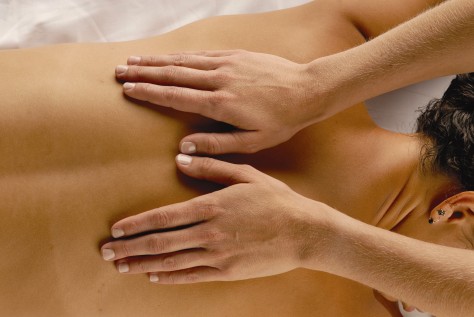
- Therapeutic Massage. If your back is caused by tense or overworked muscles, massage therapy may help. Massage can help stretch tight muscles and circulate the blood, relieving pain
- Yoga. There are several types of yoga, a board discipline that involves practicing specific postures or poses, breathing exercises and relaxation techniques. Yoga has been found to relieve stress and be effective in eliminating pain.
- Naturopathy The use of natural methods and non-toxic remedies to improve or restore health is known as naturopathy. It includes herbal remedies, homeopathic remedies, change in diet, etc.
- Physical therapy and exercise are considered alternative and natural treatments. Exercise can be very effective in treating back pain. Research studies confirm that those with osteoarthritis or sciatica back pain are greatly relieved by a daily practice of physical therapy and exercises. Be sure to consult with your trusted health practitioner before starting new exercises.
References
National Institute of Arthritis and Musculoskeletal and Skins Diseases. (2013). Handout on Health: Back Pain. Back Pain. Retrieved September 21, 2014, from http://www.niams.nih.gov/Health_Info/Back_Pain/default.asp#3
Mayo Clinic. (2014). Definition. Back Pain: Symptom. Retrieved September 21, 2014, from http://www.mayoclinic.org/symptoms/back-pain/basics/definition/sym-20050878
__________________________________________________
This article is written by Hang Pham. Hang Pham is a Monterey Bay Holistic Alliance Health and Wellness Educator. Hang Pham was born in Hoc Mon, Vietnam. She came to America in 1994, becoming a U.S. citizen in 2011. Hang graduated from Seaside High School with diploma and received her AA in General Studies from Monterey Peninsula College in 2011. She received her BA in Collaborative Health and Human Services from California State University Monterey Bay (CSUMB) in 2012. In addition to working as a volunteer staff with the Monterey Bay Holistic Alliance, she currently works as a Clerical Aid in the Human Resources Department of Salinas City Hall. The Monterey Bay Holistic Alliance is a registered 501 (c) 3 nonprofit health and wellness education organization. For more information about the Monterey Bay Holistic Alliance contact us or visit our website at www.montereybayholistic.com.
is written by Hang Pham. Hang Pham is a Monterey Bay Holistic Alliance Health and Wellness Educator. Hang Pham was born in Hoc Mon, Vietnam. She came to America in 1994, becoming a U.S. citizen in 2011. Hang graduated from Seaside High School with diploma and received her AA in General Studies from Monterey Peninsula College in 2011. She received her BA in Collaborative Health and Human Services from California State University Monterey Bay (CSUMB) in 2012. In addition to working as a volunteer staff with the Monterey Bay Holistic Alliance, she currently works as a Clerical Aid in the Human Resources Department of Salinas City Hall. The Monterey Bay Holistic Alliance is a registered 501 (c) 3 nonprofit health and wellness education organization. For more information about the Monterey Bay Holistic Alliance contact us or visit our website at www.montereybayholistic.com.
Disclaimer: The Monterey Bay Holistic Alliance is a charitable, independent registered nonprofit 501(c)3 organization and does not endorse any particular products or practices. We exist as an educational organization dedicated to providing free access to health education resources, products and services. Claims and statements herein are for informational purposes only and have not been evaluated by the Food and Drug Administration. The statements about organizations, practitioners, methods of treatment, and products listed on this website are not meant to diagnose, treat, cure, or prevent any disease. This information is intended for educational purposes only. The MBHA strongly recommends that you seek out your trusted medical doctor or practitioner for diagnosis and treatment of any existing health condition.
Top 30 Yoga Benefits
What are the benefits of yoga? How does the daily discipline of yoga affect the body, mind and spirit?
What is the History of Yoga?
Yoga is a holistic health and wellness activity that both relaxes and energizes the body. Yoga is a Sanskrit word meaning “union with God.” The common belief that Yoga derives from Hinduism is a misconception. Yoga actually predates Hinduism by many centuries. Ancient archeological finds discovered the Indus Valley provided unquestionable evidence that Yoga was practiced earlier than 3,000 B.C.E. and the classical techniques of Yoga may date back to more than 5,000 years. The word Yoga means “to join or yoke together,” and it brings the body and mind together in harmony with one another. The whole system of Yoga is built on three main structures: exercise, breathing, and meditation. One of the earliest texts on Yoga is believed to have been compiled by a scholar named Patanjali. This book contains Yoga theories and practices and is entitled Yoga Sutras (“Yoga Aphorisms”) and is thought to have been written as early as the 1st or 2nd century B.C. or as late as the 5th century A.D. This system is known as “Ashtanga Yoga.” This is the eight limbs of Yoga, and referred to today as Classical Yoga. Most all forms of yoga include a variation of Patanjali’s original ancient yoga system.
What are the Different Types of Yoga?
There are over a hundred different schools of Yoga. There are many Yoga poses or postures within each of the different schools of Yoga.
 Some of the most well known schools of Yoga are as follows:
Some of the most well known schools of Yoga are as follows:
- Hatha Yoga – Hatha Yoga is the most widely practiced form of yoga in the United States. It is the branch of yoga which concentrates on physical health and mental well-being using exercises and breathing control. “Ha” can be translated to mean “sun” and “tha” to mean “moon” meaning to balance the opposite forces.
- Raja Yoga – Raja Yoga means the “King” of Yoga, or the royal path. It is a form of Hindu yoga intended to achieve control over the mind and emotions.
- Jnana Yoga – Jñāna yoga or “path of knowledge” is one of the types of yoga mentioned in Hindu philosophies. Jñāna is a Sanskrit word translated to mean “knowledge”.
- Bhakti Yoga – Bhakti yoga is a spiritual path described in Hindu philosophy as focused on love of, faith in, and surrender to God. It is a means to awaken to God consciousness. It is a selfless devotion of reaching Brahman (God) in loving service.
- Karma Yoga – Karma Yoga is selfless action to reach perfection. “Karma” is a Sanskrit term meaning “action” or deed, either physical or mental. What makes a Karma Yogi is first the experience of union with God, and then selfless action.
- Tantra Yoga – Tantra yoga is a type of yoga designed to awaken the kundalini energy in the body and addressing relationships and sexuality. In Hinduism, the word Tantra means: 1) weaving and 2) the sacred scriptures of Hinduism, presented as a dialogue between Shiva and Shakti
- Kashmir Shaivism Yoga – Kashmir Shaivism is a transformative non-dual, yogic philosophy that originated in Kashmir in the ninth century. The goal of Kashmir Shaivism is to merge in Shiva or Universal Consciousness, or realize one’s already existing identity with Shiva, by means of wisdom, yoga and grace.
 What Does Research Tell Us About the Effectiveness of Yoga?
What Does Research Tell Us About the Effectiveness of Yoga?
Sudarshan Kriya Yoga was concluded to be a potentially effective treatment in reducing or eliminating depression in a study by Janakiramaiah N and others (2000) and a review of clinical studies of the effectiveness of Hatha Yoga on depression by Uebelacker et al (2010).
The practice of yoga has been shown to be therapeutically useful in bronchial asthma. Nagarathna R, Nagendra HR (1985) concluded that “There was a significantly greater improvement in the group who practised yoga in the weekly number of attacks of asthma, scores for drug treatment, and peak flow rate.” However, a 2011 systematic review of clinical studies suggests that there is no sound evidence that yoga improves asthma.
 Multiple studies have found yoga to be a helpful treatment in low back pain such as Sherman KJ, Cherkin DC, Wellman RD, et al (2011) and Tilbrook HE, Cox H, Hewitt CE, et al. (2011). Other studies have shown yoga to be potentially helpful treatment for cardiovascular disease, such as Raub (2002), type II diabetes mellitus (Innes and Vincent, 2007), stress and hypertension (Kiecolt-Glaser JK, and others, 2010) as well as other conditions. The practice of yoga can also play a role in the rehabilitation of those who have physical and mental challenges (Uma, et al, 2008). Many other benefits are inherit in the practice of yoga as described below.
Multiple studies have found yoga to be a helpful treatment in low back pain such as Sherman KJ, Cherkin DC, Wellman RD, et al (2011) and Tilbrook HE, Cox H, Hewitt CE, et al. (2011). Other studies have shown yoga to be potentially helpful treatment for cardiovascular disease, such as Raub (2002), type II diabetes mellitus (Innes and Vincent, 2007), stress and hypertension (Kiecolt-Glaser JK, and others, 2010) as well as other conditions. The practice of yoga can also play a role in the rehabilitation of those who have physical and mental challenges (Uma, et al, 2008). Many other benefits are inherit in the practice of yoga as described below.
What Are the 30 Benefits of Yoga?
- Relieves Stress
- Improves Breathing
- Eases Pain
- Improves Circulation
- Increases Strength
- Increases Endurance
- Lowers Heart Rate
- Develops Inner Peace
- Lengthens Muscles
- Increases Flexibility

- Reduces Cortisol Level
- Improves Concentration
- Increases Range of Motion
- Dissolves Ego
- Develops Compassion
- Enhances Energy
- Heals Ailments
- Fosters Joy
- Lowers Weight
- Lubricates Joints
- Detoxes the Body

- Strengthens Abdomen
- Improves Memory
- Delays Wrinkles and Aging
- Burns Fat
- Improves Posture
- Improves Metabolism
- Builds Immune System
- Improves Balance
- Brings Harmony
Have you tried yoga? If so, how has it helped YOU? Best wishes for a yoga-riffic day!!
_______________________________
References
Bower JE, Woolery A, Sternlieb B, et al. Yoga for cancer patients and survivors. Cancer Control. 2005;12(3):165–171.
Innes, KE, Vincent HK, The Influence of Yoga-Based Programs on Risk Profiles in Adults with Type 2 Diabetes Mellitus: A Systematic Review, Evid Based Complement Alternat Med., Dec 2007; 4(4): 469–486.
Jain SC, Talukdar B. Bronchial asthma and Yoga. Singapore Med J 1993;34:306-308
Janakiramaiah N. , Gangadhar B.N. , Naga Venkatesha Murthy P.J. , Harish M.G., Subbakrishna, D.K., Vedamurthachar A. Antidepressant efficacy of Sudarshan Kriya Yoga (SKY) in melancholia: a randomized comparison with electroconvulsive therapy (ECT) and imipramine Volume 57, Issue 1 , Pages 255-259, January 2000
Kiecolt-Glaser JK, Christian L, Preston H, et al. Stress, inflammation, and yoga practice. Psychosomatic Medicine. 2010;72(2):113–121.
Monro R, Power J, Coumar A, Nagarathna R, Dandona P. Original research yoga therapy for NIDDM; A controlled trial. Complem Med J 1992;6:66-68.
Nagarathna R, Nagendra HR. Yoga for bronchial asthma; A controlled study. Br Med J 1985;291:1077-1079.
Ramesh L. Bijlani, Rama P. Vempati, Raj K. Yadav, Rooma Basu Ray, Vani Gupta, Ratna Sharma, Nalin Mehta, and Sushil C. Mahapatra. A Brief but Comprehensive Lifestyle Education Program Based on Yoga Reduces Risk Factors for Cardiovascular Disease and Diabetes Mellitus The Journal of Alternative and Complementary Medicine. April 2005, 11(2): 267-274. doi:10.1089/acm.2005.11.267.
Raub, JA. Psychophysiologic effects of hatha yoga on musculoskeletal and cardiopulmonary function: a literature review. The Journal of Alternative and Complementary Medicine. 2002;8(6):797–812.
Sherman KJ, Cherkin DC, Wellman RD, et al. A randomized trial comparing yoga, stretching, and a self-care book for chronic low back pain. Archives of Internal Medicine. 2011;171(22):2019–2026.
Telles S, Naveen K V. Yoga for rehabilitation : An overview, Vivekananda Kendra Yoga Research Foundation, No. 19, K.G. Nagar, Bangalore-560 019., India, Indian J Med Sci 1997;51:123-7Monro R, Power J, Coumar A, Nagarathna R, Dandona P. Original research yoga therapy for NIDDM; A controlled trial. Complem Med J 1992;6:66-68.
Tilbrook HE, Cox H, Hewitt CE, et al. Yoga for chronic low back pain: a randomized trial. Annals of Internal Medicine. 2011;155(9):569–578.
Uebelacker LA, Epstein-Lubow G, Gaudiano BA, et al. Hatha yoga for depression: a critical review of the evidence for efficacy, plausible mechanisms of action, and directions for future research. Journal of Psychiatric Practice. 2010; 16(1):22–33.
Uma K, Nagendra HR, Nagarathna R., Vaidehi S, and Seethalakshmi R., The integrated approach of yoga: a therapeutic tool for mentally retarded children: a one-year controlled study, Journal of Intellectual Disability Research, Vol 33, Issue 5, 28 JUN 2008, DOI: 10.1111/ j.1365-2788.1989.tb01496
_________________________________
 This article is written by Jean Voice Dart, M.S. Special Education from Illinois State University. Jean is a published author and has written hundreds of health articles as well as hosting a local television program, “Making Miracles Happen.” She is a Registered Music Therapist, Sound Therapist, and Master Level Energetic Teacher, and is the Executive Director, founder and Health and Wellness Educator of the Monterey Bay Holistic Alliance. The Monterey Bay Holistic Alliance is a registered 501 (c) 3 nonprofit health and wellness education organization. For more information about the Monterey Bay Holistic Alliance contact us or visit our website at www.montereybayholistic.com.
This article is written by Jean Voice Dart, M.S. Special Education from Illinois State University. Jean is a published author and has written hundreds of health articles as well as hosting a local television program, “Making Miracles Happen.” She is a Registered Music Therapist, Sound Therapist, and Master Level Energetic Teacher, and is the Executive Director, founder and Health and Wellness Educator of the Monterey Bay Holistic Alliance. The Monterey Bay Holistic Alliance is a registered 501 (c) 3 nonprofit health and wellness education organization. For more information about the Monterey Bay Holistic Alliance contact us or visit our website at www.montereybayholistic.com.
Disclaimer: The Monterey Bay Holistic Alliance is a charitable, independent registered nonprofit 501(c)3 organization and does not endorse any particular products or practices. We exist as an educational organization dedicated to providing free access to health education resources, products and services. Claims and statements herein are for informational purposes only and have not been evaluated by the Food and Drug Administration. The statements about organizations, practitioners, methods of treatment, and products listed on this website are not meant to diagnose, treat, cure, or prevent any disease. This information is intended for educational purposes only. The MBHA strongly recommends that you seek out your trusted medical doctor or practitioner for diagnosis and treatment of any existing health condition.
Understanding Epilepsy – Are Natural Treatments Effective?
What is epilepsy and how is it treated? Are there alternative or natural approaches to treating epilepsy? When it comes to the subject of epilepsy, many people find it difficult to fully understand the disorder and all of its characteristics. Even though signs of epilepsy in people were present centuries ago, epilepsy is a relatively new discovery in the world of health. Before the advancement of medical technology, those with epilepsy might have been look upon by others with confusion.
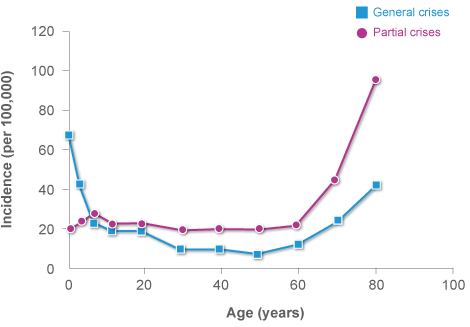
The Center of Disease Control & Prevention states that “2.3 million adults and 467,711 children (0-17 years of age) in the United States have epilepsy”. The incidence of the diagnosis of epilepsy has increased in the last few decades. There is a higher incidence of seizures among infants and elderly citizens over the age of 70.
What is Epilepsy? 
Epilepsy is a term used to express an array of brain disorders caused by seizures. Depending on the type of epilepsy, the disorder may be short-term or long-term. Epilepsy is characterized by a tendency for recurrent seizures. A seizure occurs when nerve cells in the brain signal abnormally causing temporary disruption in brain function. Neurons are overly stimulated which can lead to involuntary muscle spasms or convulsions, changes in behavior and/or changes in awareness or sensation. There are three main types of seizures: generalized seizures, partial or focal seizures and absence or petit mal seizures. Generalized seizures involve all parts of the brain. The Epilepsy Foundation provides the sub-types of generalized seizures in the following:
- Grand Mal Seizures- unconsciousness and convulsions
- Myoclonic Seizures- isolated jerking movements
- Clonic Seizures- repetitive jerking movements
- Tonic Seizures- muscle stiffness
- Atonic Seizures- loss of muscle tone
Symptoms Specific to Types of Seizures

Generalized or tonic clonic seizures affect the entire brain. The person falls to the floor and shakes or twitches uncontrollably, and is unable to speak.
Generalized or Tonic-Clonic Seizures – With a generalized or tonic-clonic seizure, the person experiences muscle stiffness, loss of consciousness and/or flailing arms and legs. They may lose control of bowel or bladder, may have trouble breathing and turn blue or be foaming at the mouth.
The generalized seizure may last seconds or minutes. After the seizure, the person may feel very confused and it may take up to an hour for him/her to fully regain awareness of the situation.
Partial or Focal Seizures – During partial or focal seizures, part of the brain is affected. The part of the brain that is affected will determine which kind of symptoms arise. For example, if the occipital lobe is affected, the person may experience temporary blurry vision or is extremely sensitive to light. Within this category of seizures, there are also simple and complex partial seizures. Refer to diagrams A and B below.
A. Simple Partial Seizures
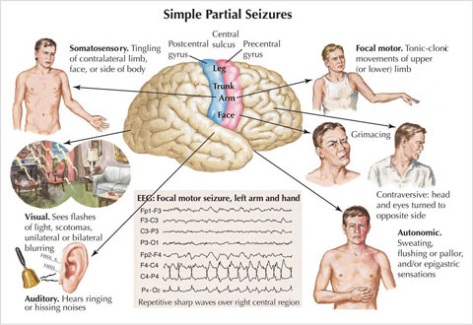
Simple partial seizure symptoms include arm twitching, tingling of face or one side of the body, seeing flashes of light, hearing ringing or hissing, sweating or flushing, facial grimacing or turning of head to one side.
B. Complex Partial Seizures
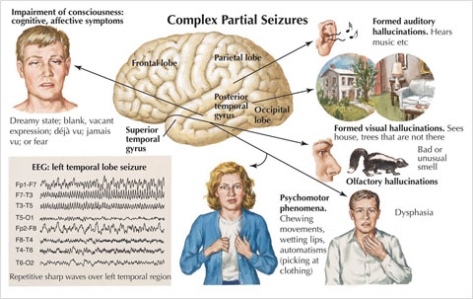
Complex partial seizure symptoms include chewing movements, wetting lips, and picking at clothing, dysphasia or trouble speaking, and auditory, visual or olfactory hallucinations.
 Absence seizures can occur many times in a day. People who have these seizures may exhibit moments of confusion, staring blanking and excessive blinking. Often absence or petit mal seizures go undetected because episodes can be brief but happen multiple times during the day or multiple times every hour. For more detailed information on each of the seizure types and symptoms, the Epilepsy Foundation is a very good resource.
Absence seizures can occur many times in a day. People who have these seizures may exhibit moments of confusion, staring blanking and excessive blinking. Often absence or petit mal seizures go undetected because episodes can be brief but happen multiple times during the day or multiple times every hour. For more detailed information on each of the seizure types and symptoms, the Epilepsy Foundation is a very good resource.
Types of Epilepsy
The type(s) of seizure(s) a person has dictates which type of epilepsy is present. Epilepsy is characterized by the types of seizures a person exhibits. The major types of epilepsy include but are not limited to the following:
- Idiopathic Generalized Epilepsy
- Childhood Absence Epilepsy
- Juvenile Myoclonic Epilepsy
- Photosensitive Epilepsy
- Benign Rolandic Epilepsy
Idiopathic Generalized Epilepsy
Since there are so many different types of epilepsy, we will focus on idiopathic generalized epilepsy (IGE) or primary generalized epilepsy. According to an article written by Selim Benbadis & Leanne Heriaud from Tampa General Hospital, entitled “Idiopathic Generalized Epilepsy,” patients with IGE experience the following type of seizures:
- Patients with IGE have one or more of 3 types of (primary generalized) seizures: myoclonic, absence and generalized tonic-clonic seizures.
- One type may be the only or main type in a given patient.
- Generalized tonic-clonic seizures are convulsions of the whole body lasting 1-2 minutes, and are the most common and most dramatic type of seizures.
- Absence seizures are brief staring spells with arrest of activity, often with eye fluttering, which last just a few seconds.
- Myoclonic seizures are very brief isolated body jerks that tend to occur in the morning.
Cause(s) of Idiopathic Generalized Epilepsy
Idiopathic generalized epilepsy is presumed to have a genetic cause however in many cases of epilepsy, a family history of the disorder may not be present. Patients with IGE who have a family history of the disorder may find it difficult to determine which family member will be born with IGE. The symptoms or seizures associated with IGE often start during childhood or adolescence. 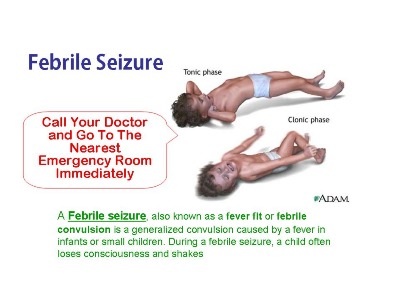 Seizures that occur during childhood and associated with high fevers are termed “febrile seizures,” and are not uncommon. Children and adults can have seizures and not be diagnosed with epilepsy. The diagnosis of epilepsy is not made after only one incidence of seizure, but instead it is made after recurrent episodes of seizures. The Center of Disease Control & Prevention offers some possible theories of events that may lead to epilepsy:
Seizures that occur during childhood and associated with high fevers are termed “febrile seizures,” and are not uncommon. Children and adults can have seizures and not be diagnosed with epilepsy. The diagnosis of epilepsy is not made after only one incidence of seizure, but instead it is made after recurrent episodes of seizures. The Center of Disease Control & Prevention offers some possible theories of events that may lead to epilepsy:
- Oxygen deprivation during childhood
- Brain infections such as meningitis, encephalitis, or brain abscessTraumatic brain injury or head injury
- Stroke resulting from a block or rupture of a vessel in the brain
- Other neurologic brain diseases such as Alzheimer Disease
- Brain Tumors
- Certain Genetic Disorders
Diagnosis of Idiopathic Generalized Epilepsy
For physicians, it’s challenging to exactly pinpoint the type of epilepsy a patient may have. Patients with IGE have normal intelligence and score in the normal range on neurological exams. One method to most accurately diagnose a patient with IGE is to perform electroencephalogram (EGG) tests.
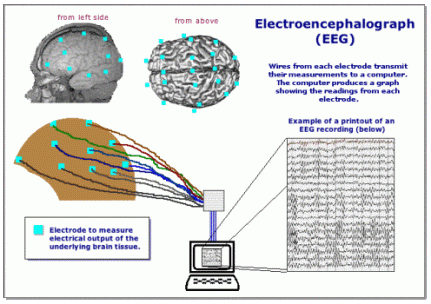 Flat metal discs are attached to the patient’s scalp to tract electrical activity in the brain. When the patient is having a seizure, the device documents the spikes. Other tests to assist physicians in diagnosing epilepsy include: Magnetic Resonance Testing (MRI), Positron Emissions Tomography (PET) Scan and Magnetic Resonance Spectroscopy (MRS). A good resource for more information about diagnostic tests for epilepsy is the John Hopkins Hospital School of Medicine, Neurology and Neurosurgery,“Diagnosing Seizures and Epilepsy.”
Flat metal discs are attached to the patient’s scalp to tract electrical activity in the brain. When the patient is having a seizure, the device documents the spikes. Other tests to assist physicians in diagnosing epilepsy include: Magnetic Resonance Testing (MRI), Positron Emissions Tomography (PET) Scan and Magnetic Resonance Spectroscopy (MRS). A good resource for more information about diagnostic tests for epilepsy is the John Hopkins Hospital School of Medicine, Neurology and Neurosurgery,“Diagnosing Seizures and Epilepsy.”
Orthodox Treatments for Idiopathic Generalized Epilepsy
No cure for Idiopathic Generalized Epilepsy (IGE) currently exists so finding the proper treatment is very important to maintain a healthy lifestyle. People with IGE can live a normal life span.
Prescription Drugs – Most patients diagnosed with idiopathic generalized epilepsy take medication to control their seizures. All prescription drugs have side effects. Some have potentially severe side effects. The medications to help control the incidence of seizures in patients with IGE include but are not limited to the following:
- Valproate
- Lamotrigine
- Topiramate
- Levetiracetam
- Ethosuximide
- Zonisamide
Alternative Treatments for Idiopathic Generalized Epilepsy
Alternative treatments for epilepsy include:
- Ketogenic Diet – A ketogenic diet may be considered to control IGE seizures. The diet is high in fat and low in carbohydrates. Ketones are formed when fat is used for the body’s source of energy. High ketone levels have been indicated to increase seizure control.
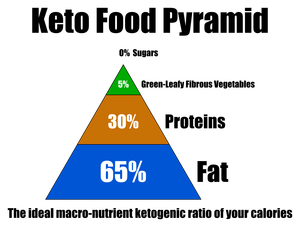 Vining concludes, in a research review entitled “Tonic and atonic seizures: medical therapy and ketogenic diet. ” Epilepsia. 2009, that “Although these seizures are often very difficult to control, some of our medications/therapies have been shown to be effective. Recommendations concerning the efficacy of these therapies and a review of the newer therapies are provided. In addition, the ketogenic diet has been particularly successful in treating these seizures; this is discussed in some detail.”
Vining concludes, in a research review entitled “Tonic and atonic seizures: medical therapy and ketogenic diet. ” Epilepsia. 2009, that “Although these seizures are often very difficult to control, some of our medications/therapies have been shown to be effective. Recommendations concerning the efficacy of these therapies and a review of the newer therapies are provided. In addition, the ketogenic diet has been particularly successful in treating these seizures; this is discussed in some detail.”
Ketogenic diets have been successful with pediatric epilepsy in young children. Almost half of children and young people with epilepsy who have tried some form of this diet reduced seizures by at least 50% and maintained this decrease even after discontinuing the diet. Constipation, was the most common negative effect, affecting about 30% of patients, due to fluid restriction. This led to increased risk of kidney stones.
- Biofeedback– Biofeedback has been found to be an effective treatment for epilepsy. Relaxation techniques are used to control the body’s functions such as heart beat and blood pressure. Biofeedback may help control seizures that are triggered by stressful life events. In 10 research studies by Tan et al., (2009), Meta-analysis of EEG biofeedback in treating epilepsy, studied 87 patients whose seizures were not controlled by drug therapy.
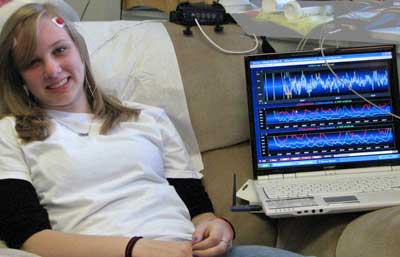 Those with contingent EEG biofeedback all the studies showed fewer weekly seizures and a significant reduction (P < 0.05) in the frequency of seizures. The researchers concluded that neurofeedback training is a possible treatment in patient whose seizures do not respond to medical therapies.
Those with contingent EEG biofeedback all the studies showed fewer weekly seizures and a significant reduction (P < 0.05) in the frequency of seizures. The researchers concluded that neurofeedback training is a possible treatment in patient whose seizures do not respond to medical therapies.
- Herbal remedies – Since ancient times, herbal remedies have been utilized in Traditional Chinese medicine for epilepsy.

In the US, herbal medicines are regulated by the 1994 Dietary Supplement and Health Education Act. Herbal remedies might be helpful in reducing the incidence of seizures, however, a study by Saper et al., 2004, “Heavy metal content of Ayurvedic herbal medicine products.” conducted in Boston with 70 herbal medicines found that 20% of these products contain potentially harmful levels of neurotoxic materials such as lead, mercury or arsenic that may cause seizures. 80% of the preparations did not contain harmful products, however. Some of the herbs that have been known to be effective in treating epileptic seizure side effects (nausea, headache, fatigue, etc.) are listed below:
Ailanthus altissima (Tree of Heaven)
Artemisia vulgaris (mugwort)
Calotropis procera (calotropis)
Cannabis sativa (marijuana)
Centella asiatica (hydrocotyle)
Convallaria majalis (lily of the valley)
Dictamnus albus (burning bush)
Paeonia officinalis (peony)
Scutellaria lateriflora (scullcap)
Senecio vulgaris (groundsel)
Taxus baccata (yew)
Valeriana officinalis (valerian)
Viscum album (mistletoe)
Gingko biloba, ephedra, eucalyptus, pennyroyal, shankhapusphi, star fruit, star anise & sage are some of the herbal medicines containing neurotoxic components which can induce seizures (Samuels et al., 2008), and should not be used by epileptic patients. More research is needed regarding the effectiveness of herbal remedies.
- Essential Oils – Essential oils can be effecting in calming the epileptic patient and preventing the symptoms of epilepsy. Such calming oils include: jasmine, ylang ylang, chamomile, and lavender (not spike lavender which is not recommended). Research was carried out at the University of Birmingham’s seizure clinic which involved using essential oils with individuals who had epilepsy.
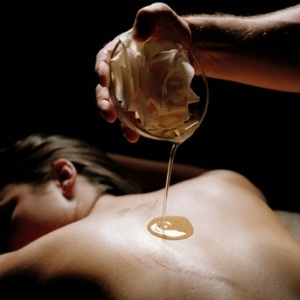 The studies used aromatherapy massage to allow individuals to associate the smell of an essential oil with a state of relaxation. Researchers concluded that the aroma triggers relaxation and can help to reduce seizures. According to the University of Maryland Medical Center, the following essential oils should be avoided: Eucalyptus (Eucalyptus globulus), Fennel (Foeniculum vulgare), Hyssop (Hyssopus officinalis), Pennyroyal (Mentha pulegium), Rosemary (Rosmarinus officinalis), Sage (Salvia officinalis), Tansy (Tanacetum vulgare), Thuja (Thuya occidentalis), and Wormwood (Artemesia absinthium) For more information about aromatherapy contact the Aromatherapy Council
The studies used aromatherapy massage to allow individuals to associate the smell of an essential oil with a state of relaxation. Researchers concluded that the aroma triggers relaxation and can help to reduce seizures. According to the University of Maryland Medical Center, the following essential oils should be avoided: Eucalyptus (Eucalyptus globulus), Fennel (Foeniculum vulgare), Hyssop (Hyssopus officinalis), Pennyroyal (Mentha pulegium), Rosemary (Rosmarinus officinalis), Sage (Salvia officinalis), Tansy (Tanacetum vulgare), Thuja (Thuya occidentalis), and Wormwood (Artemesia absinthium) For more information about aromatherapy contact the Aromatherapy Council
- Acupuncture -The effectiveness of acupuncture in treating epilepsy has not been statistically significant. A review of acupuncture in epilepsy, “Acupuncture for epilepsy” by Cheuk et al., (2009) included eleven randomized controlled trials. The authors suggested that studies using a larger sample size with appropriate standardized control groups are necessary to assess the effectiveness of acupuncture on treating epilepsy. They concluded that more studies are needed.
- Yoga– Yoga has been shown to be an effective treatment for epilepsy patients. In a research study conducted by Sathyaprabha et al., 2008, “Modulation of cardiac autonomic balance with adjuvant yoga therapy in patients with refractory epilepsy,” 18 members performed yoga (breathing exercise, meditation & yoga postures) and 16 members performed non-yoga exercise (quiet sitting & simple physical exercise) for one hour daily for 10 weeks.
 The researchers determined that the yoga group showed significant reduction in seizures (P<0.05) with improved parasympathetic parameters compared to no changes in the non-yoga exercise group. Thus it was concluded that yoga might be used effectively as an alternative therapy in management of autonomic dysfunction in patients with refractory epilepsy.
The researchers determined that the yoga group showed significant reduction in seizures (P<0.05) with improved parasympathetic parameters compared to no changes in the non-yoga exercise group. Thus it was concluded that yoga might be used effectively as an alternative therapy in management of autonomic dysfunction in patients with refractory epilepsy.
- Homeopathic Remedies – A few studies examined the effects of homeopathic remedies but were inconclusive. More research is needed. The following homeopathic remedies may be effective with eliminating associated epileptic symptoms (such as nausea, dizziness, and fever) and have no harmful side effects.
Belladonna — for seizures with a high fever
Causticum — for individuals with seizures triggered by feelings of sadness, grief, hopelessness and fear
Cicuta — for individuals with seizures after a head injury
Cuprum metallicum — for individuals with mental dullness; may be triggered by menstruation or vomiting
- Vitamin Supplements– Eating a well-balanced diet rich in vitamins and minerals may help maintain adequate mental function. People with epilepsy taking seizure medications do appear to have an increased need for calcium and vitamin D to help keep their bones healthy. Large doses of vitamin supplements, unsupervised, do not improve epilepsy and may even be harmful. Some epileptic medications can result in depletion of nutrients and vitamins. Folic acid supplements can be helpful in replenishing vitamin loss caused by medication.
 According to A.R. Gaby (2007), in a review entitled, “Natural Approaches to Epilepsy,” clinical observations and laboratory findings support the benefits of Vitamin E, magnesium, Manganese, thiamine (to improve cognitive function), folic acid, biotin, vitamin D, and L-Carnitine (to prevent valproate toxicitiy with epilepsy patients.
According to A.R. Gaby (2007), in a review entitled, “Natural Approaches to Epilepsy,” clinical observations and laboratory findings support the benefits of Vitamin E, magnesium, Manganese, thiamine (to improve cognitive function), folic acid, biotin, vitamin D, and L-Carnitine (to prevent valproate toxicitiy with epilepsy patients.
Vitamin E was found to be effective in reducing seizures in children according to a 1989 study conducted by Ogunmekan AO, MD. Twenty-four children age 6-17 were randomly assigned to 400 IU/day vitamin E or placebo for three months. of the 12 patients given vitamin E, 10 had a greater than 60% reduction in seizures. None of the placebo group had greater than 60% reduction. 6 out of the 12 children in the vitamin E group had 90-100% reduction in seizures. The study was statistically significant (p<0.05). People who not take take blood thinners should not take Vitamin E.
Other supplements such as Vitamin B6, taurine, vitamin K, melatonin and progesterone, were either uncontrolled trials or case reports, and may be effective with epilepsy symptoms, but more controlled studies and double blind studies are needed. There has been some research on the effects of omega-3 fatty acids on the reduction of epileptic seizures. Fish oil is mainly composed of omega-3 fatty acids (FAs), eicosapentaonoic acid (EPA) and docosahexaenoic acid (DHA). Pischon et al. (2003) concluded that increasing the intake of omega-3 FAs can reduce the plasma inflammatory markers and Schlanger (2002) concluded in a study entitled, “Diet enriched with omega-3 fatty acids alleviates convulsion symptoms in epilepsy patients,” that EPA could reduce seizures by decreasing these markers.
Always consult with your trusted health practitioner when making decisions regarding treatment. Alternative and complementary holistic health practices can be used in conjunction with orthodox or western medicine. Trust your own body wisdom and seek out professional advice.
Resources:
Center of Disease Control & Prevention
Epilepsy Foundation
Johns Hopkins Medicine
Epilepsy Society – Complimentary Therapies
NYU Langone Medical Center Comprehensive Epilepsy Center – Alternative Therapies
Epilepsy Health Center – Alternative Treatments to Epilepsy – WebMD
University of Maryland Medical Center -Seizure Disorders
National Center of Complementary and Alternative Medicine
Research References:
Benbadis S, and Heriaud L, “Idiopathic (Primary) Generalized Epilepsy,” Tampa General Hospital
Cheuk DKL, Wong V. Acupuncture for epilepsy (Review). Cochrane Database Syst Rev 2009; (4):CD005062.
Gaby AR, “Natural Approaches to Epilepsy,” (Review). Alternative Medicine Rev 2007; 12:1
Kossoff EH, Rho JM. Ketogenic diets: evidence for short- and long-term efficacy. Neurotherapeutics. 2009 Apr;6(2):406-14. Review.
Levy RG, Cooper PN, Giri P. Ketogenic diet and other dietary treatments for epilepsy. Cochrane Database Syst Rev. 2012 Mar 14;3:CD001903.
Li Q, Chen X, He L, Zhou D. Traditional Chinese medicine for epilepsy. Cochrane Database Syst Rev. 2009 Jul 8;(3):CD006454. Review.
Ogunmekan AO, Hwang PA. A randomized, double-blind, placebo-controlled, cllinical trial of d-alpha-trocopheryl acetate (vitamin E), as add-on therapy, for epilepsy in children. Epilepsia 1989;30:84-89.
Patel Y, and Welborn M, Alternative Therapies in Treating Epilepsy, ICE Epilepsy Alliance, Intractible Childhood Epilepsy
Pischon T, Hankinson SE, et al.: Habitual dietary intake of n-3 and n-6 fatty acids in relation to inflammatory markers among US men and women. Circulation 2003; 108:155–60.
Samuels N, Finkelstein Y, et al.: Herbal medicine and epilepsy: Proconvulsive effects and interactions with antiepileptic drugs. Epilepsia 2008, 49(3):373–380.
Saper RB, Kales SN, et al.: Heavy metal content of Ayurvedic herbal medicine products. JAMA 2004, 292:2868–2873.
Sathyaprabha TN, Satishchandra P, et al.: Modulation of cardiac autonomic balance with adjuvant yoga therapy in patients with refractory epilepsy. Epilepsy Behav 2008, 12:245-252.
Schlanger S, Shinitzky M, Yam D. Diet enriched with omega-3 fatty acids alleviates convulsion symptoms in epilepsy patients. Epilepsia 2002; 43:103–4.
Tan G, Thornby J, et al.: Meta-analysis of EEG biofeedback in treating epilepsy. Clinical EEG and neuroscience 2009, Vol.40 No. 3.
Vining EP. Tonic and atonic seizures: medical therapy and ketogenic diet. Epilepsia. 2009 Sep;50 Suppl 8:21-4. Review.
______________________________
 This article is written by Hang Pham and Jean Voice Dart. Hang Pham is a Monterey Bay Holistic Alliance Health and Wellness Educator. Hang Pham was born in Hoc Mon, Vietnam. She came to America in 1994, becoming a U.S. citizen in 2011. Hang graduated from Seaside High School with diploma and received her AA in General Studies from Monterey Peninsula College in 2011. She received her BA in Collaborative Health and Human Services from California State University Monterey Bay (CSUMB) in 2012. In addition to working as a volunteer staff with the Monterey Bay Holistic Alliance, she currently works as a Clerical Aid in the Human Resources Department of Salinas City Hall.
This article is written by Hang Pham and Jean Voice Dart. Hang Pham is a Monterey Bay Holistic Alliance Health and Wellness Educator. Hang Pham was born in Hoc Mon, Vietnam. She came to America in 1994, becoming a U.S. citizen in 2011. Hang graduated from Seaside High School with diploma and received her AA in General Studies from Monterey Peninsula College in 2011. She received her BA in Collaborative Health and Human Services from California State University Monterey Bay (CSUMB) in 2012. In addition to working as a volunteer staff with the Monterey Bay Holistic Alliance, she currently works as a Clerical Aid in the Human Resources Department of Salinas City Hall.
 Jean Dart, M.S. Special Education from Illinois State University, is a published author and has written hundreds of health articles as well as hosting a local television program, “Making Miracles Happen.” She is a Registered Music Therapist, Sound Therapist, and Master Level Energetic Teacher, and is the Executive Director, founder and Health and Wellness Educator of the Monterey Bay Holistic Alliance. To find out more about our Health Educators, or to apply as a Monterey Bay Holistic Alliance writer or volunteer, visit our website at www.montereybayholistic.com
Jean Dart, M.S. Special Education from Illinois State University, is a published author and has written hundreds of health articles as well as hosting a local television program, “Making Miracles Happen.” She is a Registered Music Therapist, Sound Therapist, and Master Level Energetic Teacher, and is the Executive Director, founder and Health and Wellness Educator of the Monterey Bay Holistic Alliance. To find out more about our Health Educators, or to apply as a Monterey Bay Holistic Alliance writer or volunteer, visit our website at www.montereybayholistic.com
Disclaimer: The Monterey Bay Holistic Alliance is a charitable, independent registered nonprofit 501(c)3 organization and does not endorse any particular products or practices. We exist as an educational organization dedicated to providing free access to health education resources, products and services. Claims and statements herein are for informational purposes only and have not been evaluated by the Food and Drug Administration. The statements about organizations, practitioners, methods of treatment, and products listed on this website are not meant to diagnose, treat, cure, or prevent any disease. This information is intended for educational purposes only. The MBHA strongly recommends that you seek out your trusted medical doctor or practitioner for diagnosis and treatment of any existing health condition.
Sciatica Pain – What is It? How Can it be Prevented and Treated?
 What are the symptoms of sciatica? Why does a pain in your back affect your leg and foot?
What are the symptoms of sciatica? Why does a pain in your back affect your leg and foot?
What are sciatica symptoms?
Sciatica usually affects only one side of the lower body. Often, the pain extends from the lower back all the way through the back of the thigh and down through the leg. Sciatica can sometimes be misdiagnosed. Sometimes people experience numbness or weakness. Sometimes it is a tingling sensation. Depending on where the sciatic nerve is affected, the pain may also travel down to the foot or toes. Some of the symptoms are:
- one-sided pain
- weakness or numbness of the thigh and leg
- tingling sensations
- pain, tingling or weakness of the foot or toes
- lower back sharp pain when bending
- continuous or intermittent pain
- disabling pain
For some people, the pain or weakness from s ciatica can be continuous, quite severe and disabling. For others, the sciatica pain might be infrequent and irritating, but it is possible that it may get worse over time. The severity of the symptoms depends on the cause of the sciatica.
ciatica can be continuous, quite severe and disabling. For others, the sciatica pain might be infrequent and irritating, but it is possible that it may get worse over time. The severity of the symptoms depends on the cause of the sciatica.
What causes sciatica?
Sciatica is often a result of a lumbar disc herniation. However, any inflammation of the sciatic nerve can result in sciatica pain symptoms, such as radiculopathy. Causes of sciatica include:
- a pinched nerve from a disc
- irritation of the nerve from adjacent bones
- muscle inflammation
- internal bleeding, infections
- tumors
- injury
- and other causes.
 Sometimes sciatica occurs because of compression on the nerve during pregnancy. Sciatica pain can also be caused from long-term carrying of an oversized wallet on one side of the hip. This would cause compression upon the nerve and result in sciatica pain.
Sometimes sciatica occurs because of compression on the nerve during pregnancy. Sciatica pain can also be caused from long-term carrying of an oversized wallet on one side of the hip. This would cause compression upon the nerve and result in sciatica pain.
A herniated disk, spinal stenosis, degenerative disc disease, spondylolisthesis, or other abnormalities of vertebrae can all cause pressure on the sciatic nerve. Sciatica pain may also result from the piriformis muscle located deep in the buttocks, pinching the sciatic nerve. This is known as piriformis syndrome and usually develops after an injury or overuse. It can be difficult to diagnose.
 Piriformis syndrome has been estimated to cause 6% of sciatica, but recent studies show that it is most likely more common. This is due to electrodiagnostic and imaging techniques. It has been underdiagnosed and undertreated.
Piriformis syndrome has been estimated to cause 6% of sciatica, but recent studies show that it is most likely more common. This is due to electrodiagnostic and imaging techniques. It has been underdiagnosed and undertreated.
A person with piriformis syndrome typically complains of sciatic pain, tenderness in the buttock, and more difficulty sitting than standing. The pain usually occurs from overuse or muscle strain such as overworking at a health club, athletics, heavy work, running, high-performance athletics such as tennis, fencing, pole-vaulting, or sitting for hours at a time, and physical trauma or accident.
How is sciatica treated?
Sciatica can be treated by the following methods:
- physical therapy
- ice pack
- elevation
- surgery for treatment of a herniated disc
- acupuncture
- massage
- yoga
- chiropractic adjustments
- pain medications
Many people choose to use drugs or injections to help manage severe pain. Others have found that meditation, alternative therapies, and change of lifestyle are effective. Always check with your trusted doctor or health care practitioner before engaging in a physical therapy or exercise program for sciatic. However, the following exercises might be used to treat back pain or sciatica.
Yoga as been more successful than most other alternative therapies in helping those with back pain. According to a study published in the Annals of Internal Medicine, entitled, “Yoga for Chronic Low Back Pain: A Randomized Trial 313 adults with chronic or recurrent low back pain were studied. 93 (60%) patients offered yoga attended at least 3 of the first 6 sessions and at least 3 other sessions. The yoga group had better back function at 3, 6, and 12 months than the usual care group. Researchers concluded that “Offering a 12-week yoga program to adults with chronic or recurrent low back pain led to greater improvements in back function than did usual care.”
 In a similar study also published by the Annals of Internal Medicine, 101 adults with low back pain were randomly assigned to one of three groups. One group attended yoga classes and lessons; the second engaged in aerobics, weight training, and stretching; the third group read a self-help book about back pain. After 12 weeks, those who took yoga could better perform daily activities requiring the back than those in the other two groups. After 26 weeks, those who took yoga had less pain and better back function, and used fewer pain relievers than those in the other two groups.
In a similar study also published by the Annals of Internal Medicine, 101 adults with low back pain were randomly assigned to one of three groups. One group attended yoga classes and lessons; the second engaged in aerobics, weight training, and stretching; the third group read a self-help book about back pain. After 12 weeks, those who took yoga could better perform daily activities requiring the back than those in the other two groups. After 26 weeks, those who took yoga had less pain and better back function, and used fewer pain relievers than those in the other two groups.
In a study by L.M. Fishman entitled, “Yoga for Osteoporosis – A Pilot Study,” published in the 2009, Topics in Geriatric Rehabilitation, yoga practitioners working with 19 osteoporosis patients with an average age of 68, gained 0.76 and 0.93 points for spine and hips, respectively, on the T-scale when compared with controls (P =.01). Five patients with osteopenia were reclassified as normal; 2 patients with osteoporosis are now osteopenic. There were no injuries. Fishman concluded that yoga appears to be an effective way to build bone mineral density after menopause and that the study supported the hypothesis that practicing yoga for as little as 8 to 10 minutes daily will raise T-scale ranking in older patients.
More research is needed to determine whether these alternative therapies are helpful for sciatica pain. Check with your trusted doctor or health care provider before started a new regimen.
Resources
L.M. Fishman, “Yoga for Osteoporosis – A Pilot Study,” Topics in Geriatric Rehabilitation, Vol. 25, No. 3, pp. 244–250, 2009
Helen E. Tilbrook, BSc, MSc; Helen Cox, and others, “Yoga for Chronic Low Back Pain: A Randomized Trial” Annals of Internal Medicine, 1 November 2011, Vol 155, No. 9
_______________________________
 This article is written by Jean Voice Dart, M.S. Special Education from Illinois State University. Jean is a published author and has written hundreds of health articles as well as hosting a local television program, “Making Miracles Happen.” She is a Registered Music Therapist, Sound Therapist, and Master Level Energetic Teacher, and is the Executive Director, founder and Health and Wellness Educator of the Monterey Bay Holistic Alliance. The Monterey Bay Holistic Alliance is a registered 501 (c) 3 nonprofit health and wellness education organization. For more information about the Monterey Bay Holistic Alliance contact us or visit our website at www.montereybayholistic.com.
This article is written by Jean Voice Dart, M.S. Special Education from Illinois State University. Jean is a published author and has written hundreds of health articles as well as hosting a local television program, “Making Miracles Happen.” She is a Registered Music Therapist, Sound Therapist, and Master Level Energetic Teacher, and is the Executive Director, founder and Health and Wellness Educator of the Monterey Bay Holistic Alliance. The Monterey Bay Holistic Alliance is a registered 501 (c) 3 nonprofit health and wellness education organization. For more information about the Monterey Bay Holistic Alliance contact us or visit our website at www.montereybayholistic.com.
Disclaimer: The Monterey Bay Holistic Alliance is a charitable, independent registered nonprofit 501(c)3 organization and does not endorse any particular products or practices. We exist as an educational organization dedicated to providing free access to health education resources, products and services. Claims and statements herein are for informational purposes only and have not been evaluated by the Food and Drug Administration. The statements about organizations, practitioners, methods of treatment, and products listed on this website are not meant to diagnose, treat, cure, or prevent any disease. This information is intended for educational purposes only. The MBHA strongly recommends that you seek out your trusted medical doctor or practitioner for diagnosis and treatment of any existing health condition.
20 Alternative Approaches to Stress
 What causes stress and how can we prevent it? Are there effective alternative, holistic, and complementary practices to treating stress besides prescription drugs?
What causes stress and how can we prevent it? Are there effective alternative, holistic, and complementary practices to treating stress besides prescription drugs?
What Does Current Research Say About Treatment for Stress?
Current studies show that Americans are not satisfied with healthcare programs addressing stress.
 A recent study entitled, “Stress in America™: Missing the Health Care Connection,” was conducted online by Harris Interactive on behalf of the American Psychological Association, among 2,020 U.S. adults in August of 2012. The results of the study suggest that people are not receiving what they need from their health care providers to effectively manage stress and help them with necessary lifestyle and behavior changes needed to improve their health.
A recent study entitled, “Stress in America™: Missing the Health Care Connection,” was conducted online by Harris Interactive on behalf of the American Psychological Association, among 2,020 U.S. adults in August of 2012. The results of the study suggest that people are not receiving what they need from their health care providers to effectively manage stress and help them with necessary lifestyle and behavior changes needed to improve their health.

Stress in America – 42% reported that the leading stress symptom they experienced was anger or irritability.
A little more than half (53%) of Americans said they receive little or no support for stress management from their providers. Thirty-nine percent (39%) said that they have little or no behavior management support. Thirty-five percent (35%) of Americans said that their stress increased this past year.
What are Stress Symptoms?
Stress symptoms can be emotional, physical, behavioral and mental or psychological. A person under stress might have the following symptoms:
- easily irritated
- frustrated
- mood swings
- hopeless
- not able to relax
- low self-esteem
- paranoia
- trouble focusing
- lonely
- avoiding people and projects
- headache
- upset stomach
- diarrhea
- constipation
- muscle pain
- fatigue
- sleepiness
- insomnia
- sweating
- chills
- biting nails
- grinding teeth
- frightened
- panic attack
- trouble swallowing
- cold or flu symptoms
- shaking or shivering
- pacing
- drug use
- negativity (criticism or gossip)
How is Stress Diagnosed and Treated?
There is no specific medical test for stress but your trusted healthcare provider or family physician should do a thorough medical and psychological exam and evaluation. He or she will ask you about your family history, your work, your daily routine, and personal life to help determine “stress triggers” and discuss a plan of treatment. It might be helpful for you to keep a stress diary for a few weeks to determine causes of stress.
 The doctor might also order blood and urine lab tests, EEG, EMG, MRI, or other tests to rule out other illnesses that might be triggering stress symptoms. Basic tests will include measuring your blood pressure and completing a questionnaire to test for depression. After making diagnostic or psychological tests have been completed, your trusted healthcare practitioner may recommend treatment.
The doctor might also order blood and urine lab tests, EEG, EMG, MRI, or other tests to rule out other illnesses that might be triggering stress symptoms. Basic tests will include measuring your blood pressure and completing a questionnaire to test for depression. After making diagnostic or psychological tests have been completed, your trusted healthcare practitioner may recommend treatment.
Treatment may include lifestyle changes such as changes in diet, physical activity or exercise, meditation, or prescription medications. If you don’t feel comfortable with the doctor’s evaluation or plan of treatment, it is important that you trust yourself and your own body wisdom when making a decision. Make sure that you are working with a doctor as a member on your team, and that your healthcare professionals are working closely with you.
Which Types of Alternative Approaches Have Been Effective?
There are many types of alternative approaches that have been shown to be effective in relieving stress, however, most approaches take time and training for the person to be skilled enough to use it successfully, or for the hands-on practitioner to be successful in working cooperatively with the client to achieve success.
Research studies show that alternative approaches can ]reduce or eliminate stress symptoms. Exercise has been well-documented as a stress-reducer, as has prayer, deep breathing, and meditation. Hypnosis and massage are also highly effective alternative treatments to prescription drugs.
Some of the natural approaches to relieving stress are:
- Massage
- Yoga
- Tai Chi
- Qigong
- Deep Breathing
- Biofeedback
- Meditation
- Prayer
- Music therapy
- Art therapy
- Dance therapy
- Drama therapy
- Emotional Freedom Technique (EFT)
- Flower Essences
- Essential Oils
- Homeopathic remedies
- Light therapy
- Crystals or gemstones
- Guided imagery or visualization
- Acupuncture
- Self-hypnosis
- Psychic healing
- Energetic healing/Reiki
- Counseling or Psychiatric
- Physical therapy
- Physical Exercise
- Sex
- Chiropractic
For more information about which alternative or complimentary therapies or approaches are best for your needs in treating anxiety or stress, consult with your trusted health-care practitioner, or check out the resources below.
Resources
The American Institute on Stress
The Stress Resource Center – Harvard
Healthfinder.gov – Stress Management
Holistic Stress Management for Nurses
American Psychological Association
Huffington Post -Reduce Stress Now
Mayo Clinic – Stress Management
Keil, R.M.K. (2004) Coping and stress: a conceptual analysis Journal of Advanced Nursing, 45(6), 659–665
Viner, R. (1999) Putting Stress in Life: Hans Selye and the Making of Stress Theory. Social Studies of Science, Vol. 29, No. 3 (June 1999), pp. 391–410
O’Connor, T. M.; O’Halloran, D. J.; Shanahan, F. (2000). “The stress response and the hypothalamic-pituitary-adrenal axis: From molecule to melancholia”. QJM : monthly journal of the Association of Physicians 93 (6): 323–333.
LE Walker Post-traumatic stress disorder in women: Diagnosis and treatment of battered woman syndrome.
– Psychotherapy: Theory, Research, Practice, Training, 1991
Hayes, Steven C.; Wilson, Kelly G.; Gifford, Elizabeth V.; Follette, Victoria M.; Strosahl, Kirk. Experiential avoidance and behavioral disorders: A functional dimensional approach to diagnosis and treatment. Journal of Consulting and Clinical Psychology, Vol 64(6), Dec 1996, 1152-1168. doi: 10.1037/0022-006X.64.6.1152, Special Section: Development of Theoretically Coherent Alternatives to the DSM-IV.
_______________________________________
 This article is written by Jean Voice Dart, M.S. Special Education from Illinois State University. Jean is a published author and has written hundreds of health articles as well as hosting a local television program, “Making Miracles Happen.” She is a Registered Music Therapist, Sound Therapist, and Master Level Energetic Teacher, and is the Executive Director, founder and Health and Wellness Educator of the Monterey Bay Holistic Alliance. The Monterey Bay Holistic Alliance is a registered 501 (c) 3 nonprofit health and wellness education organization. For more information about the Monterey Bay Holistic Alliance contact us or visit our website at www.montereybayholistic.com.
This article is written by Jean Voice Dart, M.S. Special Education from Illinois State University. Jean is a published author and has written hundreds of health articles as well as hosting a local television program, “Making Miracles Happen.” She is a Registered Music Therapist, Sound Therapist, and Master Level Energetic Teacher, and is the Executive Director, founder and Health and Wellness Educator of the Monterey Bay Holistic Alliance. The Monterey Bay Holistic Alliance is a registered 501 (c) 3 nonprofit health and wellness education organization. For more information about the Monterey Bay Holistic Alliance contact us or visit our website at www.montereybayholistic.com.
Marines are Meditating! Mindfulness-Based Fitness
 Guess who is singing “Om?” Those valiant men in the Marines are now practicing yoga exercises which include meditation techniques.
Guess who is singing “Om?” Those valiant men in the Marines are now practicing yoga exercises which include meditation techniques.
EVERYBODY’S DOING IT
If you are one of many individuals who practices a daily discipline of meditation, you are not alone. Now some of the toughest men in the world have added this discipline to their rigorous training routine.
WHY ARE THE MARINES PRACTICING MEDITATION?
It is termed “Mindfulness-Based Fitness Training” and hoped that this Buddhist-inspired training will help those in the Marine Corps increase their ability control the mind, focus the attention on the moment and their mind in the present. Right now suicide and post-traumatic stress disorder rates are high. These techniques are meant to help Marines better handle stress.

The incidence of Post Traumatic Stress Disorder (PTSD) and Traumatic Brain Injury (TBI) is high among veterans
WHAT RESEARCH WAS CONDUCTED?
A research study was conducted in 2011 involving two groups of 160 Marines. One group used silent concentration and breathing techniques, under stress-induced situations, including screaming actors, controlled blasts and a setting created to look like an Afghanistan village.
The second group did not use these breathing and mindfulness techniques and were also exposed to the same combat stress-induced situation. Naval Medical Research Center scientist Douglas C. Johnson collected data and physical evidence of stress, blood and saliva samples, images of their brains and the results of problem-solving tests. The results of this research is expected to be published later this spring.
Another study by the same research scientist involves three separate control groups, each consisting of 80 Marines. One group will receive mindfulness-based training, one will practice sports psychology training techniques, and the third will be a control group. Those results will be published later this year.
RESOURCES
- National Center for PTSD – US Department of Veterans Affairs
- Mental Health US Dept. of Veteran Affairs – PTSD
- Veterans statistics: PTSD, Depression, TBI, Suicide.
REFERENCES
King, Lynda A.; King, Daniel W.; Fairbank, John A.; Keane, Terence M.; Adams, Gary A., Resilience–recovery factors in post-traumatic stress disorder among female and male Vietnam veterans: Hardiness, postwar social support, and additional stressful life events, Journal of Personality and Social Psychology, Vol 74(2), Feb 1998, 420-434.
EB Blanchard, LC Kolb, TP Pallmeyer, RJ Gerardi, A psychophysiological study of post traumatic stress disorder in Vietnam veterans – Psychiatric Quarterly, 1982 – Springer
Marines expanding use of meditation training, Washington Times
U.S. Marine Corps members learn mindfulness meditation and yoga in pilot program to help reduce stress, Associated Press, Wednesday, January 23, 2013, 11:09 AM
_________________________________
 This article is written by Jean Voice Dart, M.S. Special Education from Illinois State University. Jean is a published author and has written hundreds of health articles as well as hosting a local television program, “Making Miracles Happen.” She is a Registered Music Therapist, Sound Therapist, and Master Level Energetic Teacher, and is the Executive Director, founder and Health and Wellness Educator of the Monterey Bay Holistic Alliance. The Monterey Bay Holistic Alliance is a registered 501 (c) 3 nonprofit health and wellness education organization. For more information about the Monterey Bay Holistic Alliance contact us or visit our website at www.montereybayholistic.com.
This article is written by Jean Voice Dart, M.S. Special Education from Illinois State University. Jean is a published author and has written hundreds of health articles as well as hosting a local television program, “Making Miracles Happen.” She is a Registered Music Therapist, Sound Therapist, and Master Level Energetic Teacher, and is the Executive Director, founder and Health and Wellness Educator of the Monterey Bay Holistic Alliance. The Monterey Bay Holistic Alliance is a registered 501 (c) 3 nonprofit health and wellness education organization. For more information about the Monterey Bay Holistic Alliance contact us or visit our website at www.montereybayholistic.com.
Disclaimer:
The Monterey Bay Holistic Alliance is a charitable, independent registered nonprofit 501(c)3 organization and does not endorse any particular products or practices. We exist as an educational organization dedicated to providing free access to health education resources, products and services. Claims and statements herein are for informational purposes only and have not been evaluated by the Food and Drug Administration. The statements about organizations, practitioners, methods of treatment, and products listed on this website are not meant to diagnose, treat, cure, or prevent any disease. This information is intended for educational purposes only. The MBHA strongly recommends that you seek out your trusted medical doctor or practitioner for diagnosis and treatment of any existing health condition.








